- What Is Compost?
- What Is Erosion?
- Why Control and Prevent Erosion?
- Benefits to Using Compost for Erosion Control
- Applications and Recommended Specifications
- References
What Is Compost?
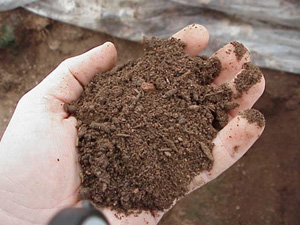 Stable compost serves as an excellent soil builder.
Stable compost serves as an excellent soil builder.Composting is the controlled biological process of decomposition and recycling of organic material into a humus rich soil amendment known as compost. Mixed organic materials (Example: manure, yard trimmings, food waste, biosolids) must go through a controlled heat process before they can be used as high quality, biologically stable and mature compost (otherwise it is just mulch, manure or byproduct). Compost has a variety of uses and is known to improve soil quality and productivity as well as prevent and control erosion.
What Is Erosion?
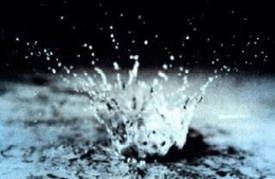 Raindrops hitting a soil surface will detach and erode soil particles.
Raindrops hitting a soil surface will detach and erode soil particles.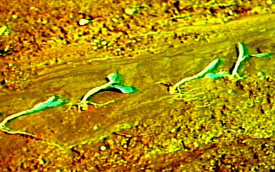 These seedlings will be stressed due to sheet erosion.
These seedlings will be stressed due to sheet erosion.  Rills are often obvious on steep or unprotected banks.
Rills are often obvious on steep or unprotected banks.Erosion is the detachment and movement of soil by moving water, wind or ice. When raindrops hit an uncovered soil surface, they dislodge and detach soil particles (splash erosion). If there is more rainfall than the ground can absorb, the resulting runoff carries these detached soil particles away.
Erosion is a natural process that cannot be stopped; however, human activity such as earthmoving and tillage can accelerate the process. The erosion process advances through several stages.
Sheet erosion is the removal of a fairly uniform layer of soil from the soil surface by shallow overland flow.
Rill erosion occurs as shallow sheet flow concentrates into small channels. Flow in these channels causes further erosion and carries soil particles away.
Gully erosion is an accelerated form of rill erosion where the channels are much deeper and carry away larger quantities of soil.
Raindrop impact on bare soil surface can also form a "crust" or pan on the soil surface that can be difficult for water to infiltrate. This creates more runoff and less water available to plants, which can decrease plant growth and ground cover leading to further erosion.
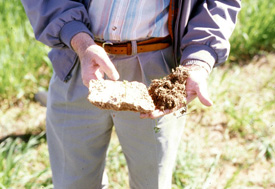 Development of soil crust reduces infiltration, causing more runoff and erosion.
Development of soil crust reduces infiltration, causing more runoff and erosion.
Why Control and Prevent Erosion?
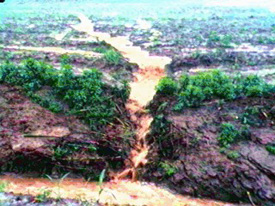 Erosion is especially critical in areas where runoff enters a stream or gully.
Erosion is especially critical in areas where runoff enters a stream or gully.According to the U.S. Department of Agriculture the United States loses more than 2 billion tons of topsoil each year to erosion. Erosion removes fertile soil rich in nutrients and organic matter, which reduces the ability of plants to establish, grow and remain healthy in the soil. A reduction in plant growth and subsequent plant residue causes less soil cover, allowing the erosion process to perpetuate and become worse. The danger in this process is that it can be imperceptible and eventually lead to infertile land void of topsoil.
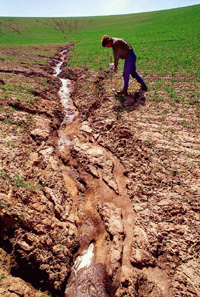 This rill could easily turn into a gully if erosion is not controlled.
This rill could easily turn into a gully if erosion is not controlled.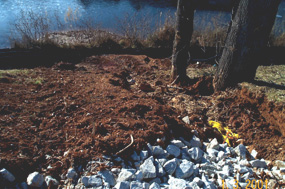 Development of soil crust reduces infiltration, causing more runoff and erosion. Eroding slopes can lead to sediment build-up in water bodies.
Development of soil crust reduces infiltration, causing more runoff and erosion. Eroding slopes can lead to sediment build-up in water bodies.
Water Quality and Conservation
Erosion not only causes loss of soil productivity but also creates water quality problems once the sediment leaves the site and enters surface waters. The U.S. EPA has declared that sediment contamination of our surface waterways is the biggest threat to our nation's water resources. When eroded sediment is transported from its site of origin to nearby water bodies it also carries fertilizers, pesticides and other contaminants attached to the soil particles.
Water that is loaded with sediments can lead to reduced drainage capacity, increased flooding, decreased aquatic organism populations, decreased commercial and recreational fishing catches, clogged and damaged commercial and industrial irrigation systems, increased expenditures at water treatment plants to clean the water, and decreased recreational and aesthetic value of water resources.
Construction and Development
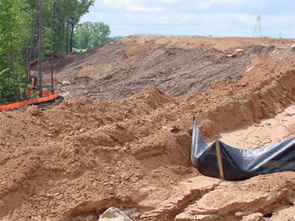
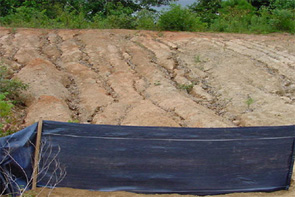
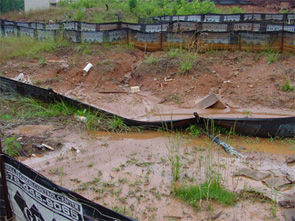
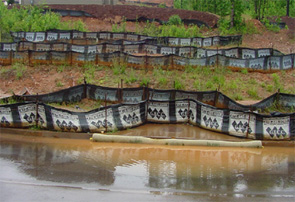 Erosion at construction sites is usually controlled with silt fences.
Erosion at construction sites is usually controlled with silt fences.Construction projects cause substantial erosion and sedimentation in Georgia's surface waters. Construction and development projects, where soil is excavated or moved around, are particularly subject to erosion problems. These project zones often have a significant challenge in establishing vegetation quickly to protect the soil due to reduced soil quality and fertility. In many cases, the existing topsoil has been totally removed making the challenge even greater. In addition, heavy machinery and constant traffic can compact the soil creating a "hard pan" that repels water, increases runoff, and prevents plant growth. Compost replaces valuable organic matter and soil nutrients essential to vegetative establishment and long-term plant health. It also "breaks-up" compacted soils and increases soil structure allowing water to infiltrate the soil surface. If immediate planting is not feasible, compost can act as a protective layer or sediment filter until vegetation can be established.
Benefits to Using Compost for Erosion Control
Using compost in highly erosive areas can decrease erosion and allow quicker establishment of vegetation. One study conducted showed compost application reduced soil loss by 86 percent compared to bare soils, and sediments reaching nearby surface waters decreased by 99 percent when compared to silt fences, and 38 percent when compared to hydroseeding applications (Demars, 1998). Once incorporated with the soil, compost can increase infiltration up to 125 percent (Demars, 1998).
Compost controls erosion by:
- Increasing water infiltration in to the soil surface.
- Reducing runoff and soil particle transport in runoff.
- Increasing plant growth and soil cover.
- Reducing soil particle dislodging.
- Increasing water holding capacity of soil which reduces runoff.
- Buffering soil pH which can increase vegetation establishment and growth.
- Alleviates soil compaction by increasing soil structure.
- New vegetation can be established directly into compost.
When used as a filter berm, compost:
- Reduces sediment from reaching surface water by acting as a filter.
- Reduces fertilizers, chemicals, metals, and other pollutants from reaching surface waters in storm water runoff.
- Can be used as a waste reduction tool -- i.e., keeps used silt fences out of the landfill and uses recycled organic materials.
- Can save you money in solid waste disposal fees, time, and cost to buy erosion control material.
- Can be left at the site when the job is done.
Applications and Recommended Specifications
There are two basic methods for using compost in erosion control: compost blankets and compost filter berms. Each method has its advantages and choosing one will depend on the slope of the site, amount of potential rainfall, activity around the site, and intended vegetation establishment. In many cases, both methods can be used in combination. Not all compost is the same. The usefulness of a particular type of compost will depend on many factors including the feedstock and processes used to make it. Specifications for compost used in erosion control include particle size, moisture content, organic matter content, pH, soluble salt content, and human-made inert contents. Application rates will usually be based on chosen method and severity of slope.
Generally, a mix of fine and course grades of compost is best for controlling erosion. The fine compost (passing through a 3/8-1/2 inch screen) will penetrate the soil surface and increase water infiltration and water holding capacity. In addition, the fine compost is essential for rapid vegetation establishment and long term soil and plant health. The long-term nutrient value that compost supplies will come from the fine compost. Coarse grades of compost (passing through a 2-3 inch screen) although harder to plant into, help to prevent splashing of raindrops directly on the soil surface and are less likely to be disturbed by rainfall and storm runoff. The coarse grades also perform like filters by "stopping" or "catching" soil particles already in motion.
Moisture content (MC) is the percentage of water within the finished compost. MC specifications range between 20 and 50 percent. Dryer composts are recommended for areas prone to high rainfall because they will absorb more water and are more likely to bind pollutants, reducing the chance of leaching to ground and surface waters. Compost that is too dry may be difficult to apply, while compost that is too wet is more expensive and difficult to transport.
Organic matter content (OM) is the percentage of carbon based materials within the finished compost. OM should range between 40 to 70 percent (dry basis).
pH is the numerical measure of acidity, or hydrogen ion concentration within the finished compost. Levels of pH should fall between 6.0 and 8.0. For most applications pH levels closer to 7.0 are recommended except for acid loving plants.
Soluble salt content is the concentration of soluble ions in a solution, which is measured by the medium's ability to conduct electrical current within the finished compost. Soluble salt levels should be between 4.0 and 6.0 mmhos/cm; use levels closer to 4.0 mmhos/cm in areas where horticultural planting will occur.
Human-made inerts content is the percentage of any foreign synthetic material (Examples: plastics, glass, metal) within the finished compost. Human-made inerts should not exceed 1.5 percent by dry weight; levels under 1.0 percent are preferable.
Nutrient content is the percentage of major nutrients within the finished compost. Finished compost will vary depending on the feedstocks used and are significantly lower than commercial fertilizers. Total nitrogen (N) ranges between 1-3 percent, organic N 1-3 percent, ammonium N 0-0.5 percent, total phosphorous (P205) 1.5-2.5 percent, and total potassium (K2O) 0.5-2.0 per-cent. You should know the nutrient content of the soil, the compost, and the nutrient uptake of the intended vegetation. This will allow efficient use of the compost and can protect nearby water sources.
Stable (no odor or heating in a moist, warm environment) and mature (cured after stability is reached to ensure premium quality) compost is essential for any application. Compost that is not stable or mature can damage plants and take soil nitrogen away from plants.
The standards in Table 1 can be used as a general rule of thumb. Other compost and mulches may control erosion but may not support plant growth.
| Table 1. Comparing advantages and disadvantages of compost blankets and filter berms. | ||
| Advantage/Disadvantage | Compost Blanket | Filter Berm |
| Particle size | 3/8 - 1/2 in. screen and 2 - 3 in. screen (ratio = 3:1) |
3/8 - 1/2 in. screen and 2 - 3 in. screen (ratio = 1:1) |
| Moisture content | 20 - 50% | 20 - 50% |
| Soluble salt | 3.0 - 6.0 mmhos/cm | 4.0 - 6.0 mmhos/cm |
| Organic matter | 40 - 70% | 40 - 70% |
| pH | 6.0 - 8.0 | 6.0 - 8.0 |
| Nitrogen content | 0.5 - 2.0% | 0.5 - 2.0% |
| Human made inerts | 0.0 - 1.0% | 0.0 - 1.0% |
| Application rate/size | 3/4 - 3 in. depth | 1 - 2 ft. (H) x 2 1/2 - 4 ft. (W) |
| Maturity | Yes/High | Yes/High |
Compost Blankets
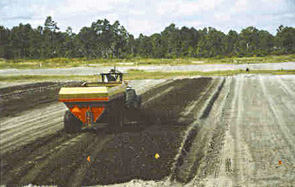
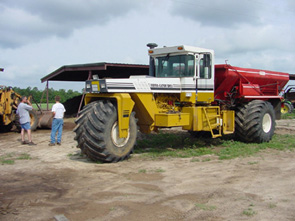 A standard agricultural manure spreader can be used to apply compost blankets on minor slopes.
A standard agricultural manure spreader can be used to apply compost blankets on minor slopes.Compost blankets or mats are surface applications of designated high quality composts on areas with erosive potential. Compost blankets can control erosion on disturbed areas such as construction sites, state DOT development (and planting) projects, exposed stream banks, and any disturbed or excavated land area with a 4:1 slope or less.
Application rates should be between 1 to 3 inches in depth (135 to 400 cubic yards per acre) with the higher rates for steeper slopes. Some gradual slopes may require as little as 3/4 inch (100 cubic yards per acre).
Particle sizes should be a mix of fine grade 1/4- to 1/2-inch screened and coarse grade 2-3 inches. Coarse grades may be larger if rapid vegetation establishment is not a primary goal. A mixture ratio of 3:1 (fine: coarse) has been recommended in many studies.
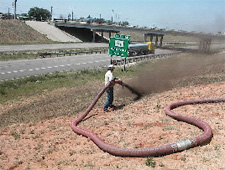
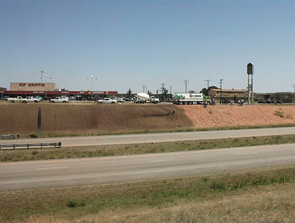 When applying compost blankets on steeper slopes or smaller areas, pneumatic blowers are more appropriate.
When applying compost blankets on steeper slopes or smaller areas, pneumatic blowers are more appropriate.Blankets and mats are easiest to apply using a pneumatic blower, especially on slopes where spreaders may not be an option. Finer compost is easier to apply and spreads more evenly using a pneumatic blower. At least 300 feet of hose is recommended when applying compost with this technology. Compost and manure spreaders are effective application devices but only work well on open, gradual slopes. It is best to apply the compost layer on the slope contour or up and down the slope to prevent water from sheeting between the compost and soil surface. Always apply compost at least 3 feet over the shoulder of the slope or into existing vegetation where possible to prevent rill formation and transport of the compost.
The primary purpose of the compost blanket is to protect the soil surface until vegetation is established. Therefore, it is important to ensure that the compost material will encourage plant growth and that the slope is seeded following compost application.
Compost Filter Berms
Compost filter berms are contoured runoff and erosion filtration methods usually used for steeper slopes with high erosive potential. The berm allows runoff water to penetrate it and continue to flow while filtering sediment and pollutants from the water. It also slows the flow down, allowing soil particles to settle out. Berms work well in many of the same areas as blankets but are the preferred method if the slope exceeds a 4:1 gradient.
Berm size and construction may vary based on slope severity and the amount of expected rainfall; larger berms are recommended for steeper slopes. Compost berms are typically contoured to the base of the slope, but a second berm may be used on the shoulder contour of steeper slopes for added protection. Berms may be windrow or trapezoidal (allows maximum water penetration) in shape and should be placed uncompacted on bare soil as soon as possible. Vegetation or compost blankets may be used in front or above the berms but never under them. Windrow shaped berms should be between 1 to 2 feet high and 2.5 to 4 feet wide. Trapezoidal berms should be approximately 2 feet high, 2 to 3 feet wide at the top, and at least 4 feet wide at the base. Never construct compost filter berms in runoff channels, ditches or gullies.
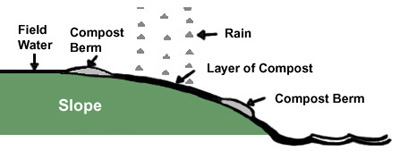 Diagram of Compost Berm, U.S. EPA.
Diagram of Compost Berm, U.S. EPA.Particle sizes should be a mix of fine (1/4 to 1/2 inch) and coarse grades of compost with no particle sizes exceeding 3 inches in length. The mixture ratio may include a greater fraction of coarser grade compost (1:1) compared to compost blankets if vegetation establishment on the berm is not a primary goal or if there is a high runoff quantity potential.
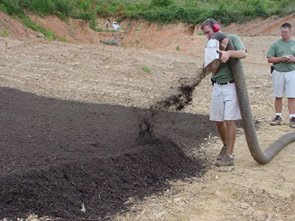
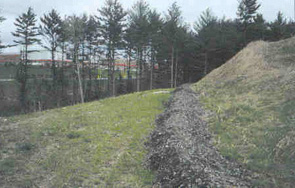 Examples of compost filter berms.
Examples of compost filter berms.Application and construction of compost berms is easiest using a backhoe, bulldozer, or grading blade. Manual application may be an option in tight or small areas.
Compost filter berms can be planted and seeded at the time of application for permanent vegetation establishment. The berm can also be spread out and planted or seeded at the end of the project. Either way, compost berms can be left at the site with no waste product or cleaning up!
References
American Association of State Highway and Transportation Officials. (2010). Standard practice for compost for erosion/sediment control (compost blankets). https://www3.epa.gov/npdes/pubs/aashto.pdf
BioCycle. (n.d.). BioCycle Connect, LLC. https://www.biocycle.net/
California Integrated Waste Management Board. (2000). Compost demonstration project, Placer County: Use of compost and co-compost as a primary erosion control material. https://www2.calrecycle.ca.gov/Publications/Details/787
Demars, K. R., & Long, R. P. (1998). Field evaluation of source-separated compost and CONEG model procurement specifications for Connecticut DOT projects (Report No. JHR-98-264). https://www.cti.uconn.edu/Document.asp?DocID=8632
Demars, K. R., Long, R. P., & Ives, J. R. (2000). Use of wood waste materials for erosion control (Report No. NETCR 20). New England Transportation Consortium. http://www.newenglandtransportationconsortium.org/files/netcr20_97-3.pdf
Iowa State University. Using compost for a safer environment.
Texas Department of Transportation. (2004). Specifications: Item 161 compost.
Texas Department of Transportation. Use of compost and shredded wood on right of way.
US Composting Council. (2001). Field guide to compost use.
US Composting Council. (2008). Using compost in stormwater management. https://cdn.ymaws.com/www.compostingcouncil.org/resource/resmgr/documents/compost_use/Compost-Use-for-Stormwater-M.pdf
US Environmental Protection Agency. (1997). Innovative uses of compost: Erosion control, turf remediation, and landscaping (EPA530-F-97-043). https://nepis.epa.gov/Exe/ZyPURL.cgi?Dockey=10000LSY.txt
Status and Revision History
Published on Aug 01, 2001
Published on Feb 20, 2009
Published on May 14, 2009
Published with Full Review on Feb 20, 2012
Published with Full Review on Feb 26, 2015
Published with Full Review on Jun 08, 2023


























































